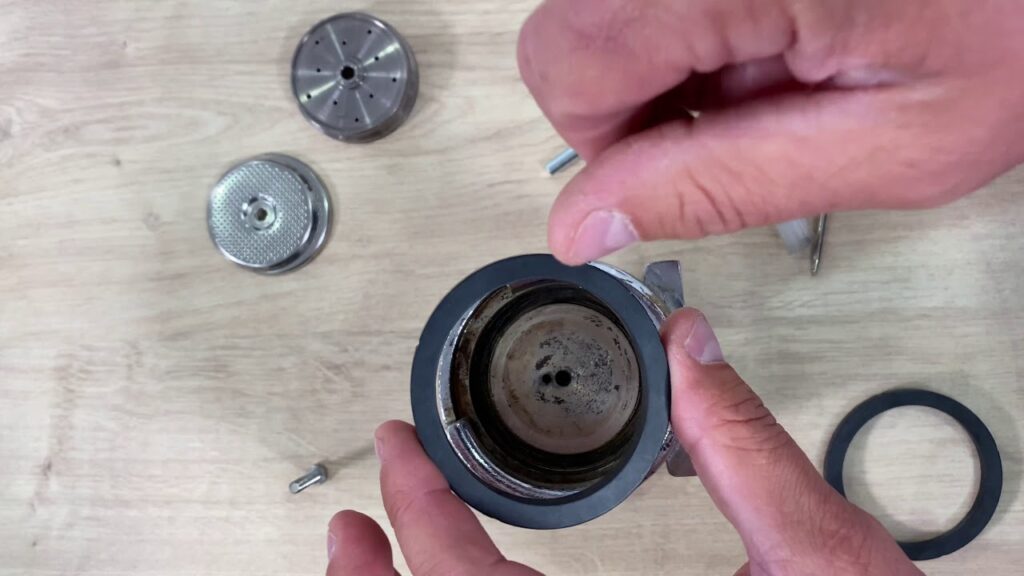Have you noticed your espresso machine leaking? Don’t worry, it’s a common problem, and there are solutions.
The most common cause of a leaking espresso machine is a worn group head gasket, which can deteriorate over time and lose its seal, leading to water leakage and a messy outcome.
In this article, we’ll help you understand why your espresso machine is leaking, how to fix it, and how to stop more leaks in the future.
Causes of Espresso Machine Leaks & How To Fix Them
The most common cause of a leaking espresso machine is a worn group head gasket. Most espresso machine owners will encounter this problem, as group head gaskets are disposable and need replacing approximately once a year.
Let’s find out how to tell if your group head gasket is worn and how to replace it.
Worn Group Head Gasket
One of the most common causes of espresso machine leaks is a worn group head gasket. This rubber seal is located just above the portafilter.

Over time, these gaskets can become brittle or cracked due to wear and tear, allowing water to escape through small cracks or gaps in the seal. A typical group head gasket in a home espresso machine might last around one year before it needs replacing.
If you see water leaking out of your espresso machine above the portafilter rather than passing through the portafilter, then this is a clear sign of a problem with your group head gasket.
Another sign of a problem with your group head gasket is your portafilter handle rotating further around than it usually does. It should stop at the six o’clock position, with the handle pointing directly towards you.
To check if this is causing your leak, inspect your gaskets for signs of damage such as cracking or brittleness.
How to Fix a Worn Group Head Gasket [11 Easy Steps]
- Remove the portafiler
- If necessary on your machine, use a screwdriver to unscrew the screw in the center of the dispersion screen, located above where the portafilter usually attaches
- Get a pick (or ‘awl’) and gently prise the gasket out of the machine. This will be easier on newer gaskets that are less damaged. Older gaskets may even break apart into pieces as you remove them, but this is nothing to worry about as long as you remove all of the pieces.
- Clean the inside of the group head where the gasket was located, ready for the new gasket.
- Apply a thin layer of food-safe lubricant around the new gasket.
- Insert the new gasket into the espresso machine using your fingers and the pick if necessary. The smooth flat side should be facing down towards the portafilter.
- Use a towel to wipe away excess lubricant.
- If you removed the dispersion screen earlier (step 2), now is the time to screw it back into place.
- Put your portafilter back.
- Check that the seal is tight. The handle should point towards you when the portafilter is locked firmly.
- Turn on the espresso machine and check that it is no longer leaking water.
Usually, replacing the group head gasket will fix a leaking espresso machine, but if it doesn’t, you may need to look deeper into the machine to check for loose connections and blocked valves.
Loose Connections
Another potential cause of leaking espresso machines is loose connections between parts like hoses and valves.
When these connections aren’t properly secured, water can be forced out of tiny openings as the water pressure builds while brewing.
If you feel confident opening up your espresso machine, inspect all hoses and valves to see if they are the source of the leak. If you find any loose valves, then tighten up those connections before using your espresso machine again.
If you can’t easily reach the valves in your model of espresso machine, or you’re not confident about what you are doing, then contact the manufacturer and take the machine for professional repair.
Blocked Valves
Sometimes a valve won’t leak because it is loose but because it is blocked. This happens when an obstruction prevents proper flow within the valve, leading to back pressure that forces water to escape from the system.
To diagnose this issue first try cleaning out any blockages by running hot water through each valve individually until it runs freely without resistance.
If that doesn’t work, you may need to replace the affected part entirely. Again, if you aren’t sure about what you are doing, speak with a professional.
Preventative Maintenance

One of the best ways to prevent espresso machine leaks is through regular maintenance. This means cleaning the machine regularly, as well as checking for any worn parts that need to be replaced.
The group head gasket is one part that will wear out over time and will likely need replacing annually.
In addition to regular cleaning and replacing worn-out components, it’s also important that you keep an eye on your water pressure levels when brewing your espresso.
If the pressure levels are too high or too low, this can cause problems with how much water flows through your coffee grounds, which can affect the taste of your espresso.
Finally, if you notice any unusual noises coming from your espresso machine then stop using it immediately, see if you can identify an obvious problem, and if not, contact a professional repair service.
Taking the time to clean your espresso machine, regularly replace consumable parts, and monitor your machine’s performance to identify any changes, will help ensure your espresso machine runs smoothly and efficiently, preventing potential issues from arising.
Final Verdict: The Reason Why Your Espresso Machine Is Leaking
If your espresso machine is leaking, with water dripping out from near the portafilter rather than running through it, we’re willing to bet that the issue is a worn group head gasket.
This is good news because the group head gasket is an easy part to replace. You should be able to replace it yourself using nothing more than a screwdriver, a pick, and some food-safe lubricant. It’s best to do this once per year, before the gasket gets too worn.
In the rare event that your espresso machine is leaking from somewhere else, and your group head gasket is not to blame, then the problem could be more difficult to fix.
It may be that you can simply find a loose valve that needs tightening or a valve that needs unblocking, but these issues can be difficult to spot.
If you aren’t sure what the problem is or how to fix it, we recommend speaking with your espresso machine manufacturer and getting a professional to repair it.
FAQ – Why is My Espresso Machine Leaking?
Common causes of an espresso machine leak include a worn group head gasket, a damaged water tank, a damaged steam wand, and loose fittings and hoses.
Check for water pooling or dripping around the group head and look for reduced pressure or steam output, or a decrease in the quality of the espresso produced.
Yes, a leaking machine can dilute the espresso and affect its taste and strength, and make it difficult to achieve the proper pressure and temperature.
Yes, other components like the water tank, steam wand, fittings, and hoses could cause a leak, and it’s important to determine the source before attempting repairs.

Hi, I’m Megan! I love coffee – especially cappuccino – and spending time with my kids. When I’m not busy being a mom, I enjoy reading magazines (or just about anything that interests me) and swimming. In fact, I used to be a swimmer in college!


Leave a Reply